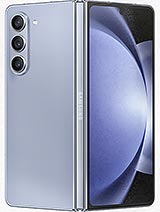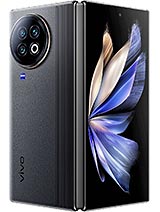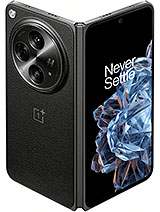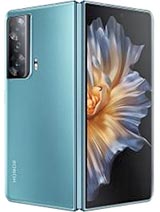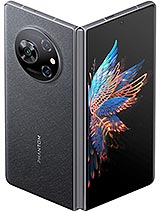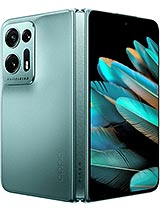OnePlus Open review

OxygenOS 13.2 on top of Android 13
The OnePlus Open boots Android 13 with the latest and foldable-compatible OxygenOS 13.2. Excluding the multi-tasking options, OxygenOS is nearly identical to Oppo's ColorOS that serves as a base for all BBK launchers. Yes, that also includes Realme UI.
OnePlus is promising four generations of OS updates and five years of security updates on the Open. Furthermore, the phone has passed TÜV SÜD 48-Month Fluency test with an A-rating, which means the OnePlus Open should be as fluid as on day 1 for a 4-year period.

The OnePlus Open unlocks via the side-mounted fingerprint scanner or via PIN/password. A less secure Face Unlock is also available.
Let's start the software tour with the Always On display, because it's the first thing you normally see before unlocking the Open.
It's a good example of a feature that works identically on both the main and the cover display, depending on whether the OnePlus Open is, well, open or not.
That applies to most of the display settings, including refresh rate, brightness, and color. In fact, OnePlus has done an excellent job of aligning the user experience between the two where it makes sense to minimize breaking the general UX flow.

The AOD can be always-on/off, scheduled, or in power saving mode (shows on move/tap). There are enough themes to choose from, support for Spotify controls and some food delivery apps is available, too. Edge Light is an option as well.






Personalization and Always-on Display
The lock screen is also shared between the two displays in pretty much all of its aspects, including the clock style, widget selection, and notification logic. All except for the wallpaper selection, which can (but doesn't need to) be done on an individual basis for the two panels.



Lock screen: Cover display • Main display • Wallpapers
The same goes for the main user interface. The Homescreens are identical on either screen; it's just that the main one shows two homescreen panes at all times instead of one.




Cover home screen • Cover app drawer • Main home screen • Main app drawer
The notification and control centers, as well as the optional app drawer look normal on the cover display, and they are expanded on the main foldable display.




Notifications • Toggles • Notifications • Toggles
The task switcher on the cover screen is a familiar affair, too. You scroll between app cards, you can lock them, you can use split-screen and/or floating window options on supported apps.




Multi-tasking on the cover screen
The Taskbar is one of the main features of the Android for foldables. This is a bar that shows a minimized view of the dock icons when you're away from the homescreen. It displays two shortcuts left from the dock icons - App Drawer and Recent Files. It also shows recently used apps (up to three) next to the four Dock shortcuts.
One of the OnePlus Open's main display strengths is the ability to have several apps displayed simultaneously in a number of configurations, including the new Open Canvas way.

First, you can have split-screen with two apps, of course. But then you can add another split-screen app next to those two and just scroll between them. You can also have the third app in fullscreen-like view on top or at the bottom of this split-screen configuration. Nice! This is what OnePlus calls Open Canvas - part of the apps can move outside the screen.
Split-screen and one floating app is a possible configuration, too.






Multi-tasking on the large screen
You cannot have more than three active on-screen apps. You can save multi-app configurations and open them later the same way from within the Task Switcher.

Drag-and-drop file/content sharing is possible, of course.


Multi-tasking on the large screen
The UI across various system apps has been optimized to make use of the large screen.



OxygenOS apps on the large screen
The OnePlus Open supports a semi-opened state. The phone is aware that it is in this state and lets the Android OS and any running app know. In this sense, a special UI will trigger behavior already baked into modern versions of Android, specifically designed to make apps more aware of the current state of foldable displays, allowing them to adapt their UI.
So far, we found it to work only on YouTube and within the Camera app.
The OnePlus Open also supports the RAM Expansion feature. As evident from the name, this feature lets you expand your smartphone's RAM - albeit virtually - by using the phone's internal storage. You can add from 4GB up to 12GB virtual RAM. This feature is active by default, and OnePlus has chosen 4GB for the default setting.
OnePlus offers a couple of proprietary apps - Photos, File Manager, IR Remote, Community.

The Photos app is the only multimedia app provided by OnePlus, and it supports videos, too. For everything else, you rely on Google's.
OnePlus also offers its own File Manager app in addition to Google's Files. There are also IR Remote and (1+) Community apps.



Photos • IR Remote • Community
OxygenOS also includes the Zen Space app to help you focus without the phone distracting you by simply preventing you from using it. There are a few predefined modes such as Deep Zen, Light Zen, Work, Study, but you can make your own thing, too.
There's also the O Relax app, which includes a variety of comforting music tracks and ambient nature sounds to relax.





Zen Space • Zen Space • Zen Space • Zen Space • O Relax • O Relax
Finally, there is also a dedicated Games center with a special performance mode, game toolkit, and granular game management. There are some new features like the Championship mode and music playback control.
Overall, we liked the standard and foldable experience on the OnePlus Open. Its cover screen is ideal for everything, but its primary one really opens it up, pun intended.
Performance and benchmarks
The OnePlus Open is powered by the Snapdragon 8 Gen 2, the standard version. This SoC has 1x3.19 GHz Cortex-X3 prime core, 2x2.8 GHz Cortex-A715 heavy hitters, 2x2.8 GHz Cortex-A710 medium cores and 3x2.0 GHz Cortex-A510 power-saving units.
The Adreno 740 GPU is in charge of graphics and it surely is among the most powerful mobile GPUs on the market right now.
The Open uses 12GB LPDDR5X RAM and 512GB UFS 4.0 storage chip.
OnePlus promises a good heat dissipation system that will properly cool "the chipset, display, cameras, modem, and other major heat sources". Here is hoping.
Let's see some benchmark scores now.

The OnePlus Open has the regular Snapdragon 8 Gen 2 version, not the one known as 'Made For Galaxy' that was used in the Fold5 and the Mix Fold3.
Then there's the matter of the High Performance Battery mode that the phone has. We tested the Open in both its default state and in 'High Performance' mode. The latter allows the CPU to run at its full potential with little consideration for battery efficiency and higher thermal thresholds. The 'regular' mode (not a setting, strictly speaking, just with 'High performance' turned off) imposes some limitations on the processor, and the phone returns CPU benchmark scores lower than the expected for the Snapdragon 8 Gen 2 and more in line with the SD8G1. The GPU isn't affected by this, and it's always working at full power.
Indeed, the default CPU scores are lower on the Open than on phones with the same chipset as the vivo X Fold2. But using the High Performance mode allows the CPU to reach the same scores.
The OnePlus Open has higher resolution than the other competitors except the Huawei Mage X3. This explains why its onscreen GPU scores are lower than on many other phones.
Unfortunately, the BBK curse transfers onto the OnePlus Open and all games and benchmarks are capped at 60FPS unless a special partnership or boost has been arranged between the developer and OnePlus.
The raw GPU offscreen scores are as impressive as they can get these days.
Finally, the AnTuTu scores are great, though a bit lower than the competition's when not using the High Performance mode.
The OnePlus is well-equipped to handle whatever app and game you throw at it and the ones we tried ran excellent on both displays. It's a pity that there are currently no games that will go above 60FPS, though.
Finally, we ran our traditional stress tests on the OnePlus Open.
The OnePlus Open is more stable when unfolded, which is to be expected. In this state we got 72% of CPU and 66% for GPU stability.
When closed, the OnePlus Open scored 64% of CPU and 66% of GPU stability.
Finally, we ran the CPU test with the Performance mode turned ON. The CPU stability on the foldable display dropped down to 61%, while the one on the cover display remained almost intact at 62%.
Then again, if we compare the average and minimum GIPS, we can see that the OnePlus Open delivered similar scores in both scenarios, it only reached more GIPS in the first 5 minutes because of the HP mode. Meaning the CPU performance does not drop lower when throttled under the HP mode compared to when throttled under the regular mode.



CPU HP test • CPU test standard • CPU HP test cover
No matter if folded or not, High Performance or not, the OnePlus never became hot even under prolonged benchmarking and stress tests. It wasn't even that warm, which is great such a smartphone. Sure, the OnePlus Open obviously throttles after a while, but it is still better than the average. For example, the new Z Fold5 lost 50% and 60% of GPU performance in folded and closed state, and it also lost 50% of its CPU power when closed.
We do not recommend using the High Performance mode. While it does boost the CPU a bit, it is also responsible for quicker CPU throttling and it's somewhat unreliable as it sometimes turns off randomly.
So, the OnePlus Open packs what is needed to be called a true flagship and it even cools rather well. If only it came with native support for High Frame Rate gaming, though...
Reader comments
- anonpoaster
- 04 Jul 2024
- Dk5
How the hell did Oneplus manage to fumble with the OP12 regarding camera quality? Open takes the best night mode pics I've seen on this site and I'm comparing it directly with a Pro 15 Max with the same scenes!
- Gaia
- 02 Jan 2024
- Y7W
Just came back to say that emulation on Android has hugely improved since I made my comment. Current version of Yuzu emulator runs most Switch games on a Oneplus 10T extremely good. The reason why a computer struggles is due to the computer's ar...
- Ryuhoshi
- 10 Dec 2023
- mME
After looking at the photos of the telephoto camera and comparing it to all of the competitors, including from last year, it seems this is by far the best telephoto camera. Look especially at the night photo from the telephoto camera of the buildin...
















